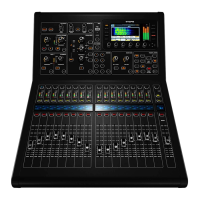30 DIGITAL RACK MIXER M32R User Manual
3. Adjust the fourth encoder to select a specic signal path to feed the
selected physical output. Choices include:
• Insert Point
• Main L
• Main R
• Main C/M
• Any of the 16 Mix Outputs
• Any of the six Matrix Outputs
• Any of the 32 Direct Outputs
• Any of the eight Auxiliary Outputs
• Any of the FX Direct Outputs
• Monitor L
• Monitor R
• Talkback.
4. Tap the fourth encoder to assign the selected output path, completing
the process.
5. Adjust the fth encoder to select the signal tap point for the output
assignment. Choices include:
• IN/LC
• IN/LC +M
• PreEQ
• PreEQ +M
• PostEQ
• PostEQ +M
• PreFdr
• PreFdr +M
• Post Fader.
6. Tap the fth encoder to complete the signal tap point assignment.
7. Tap the 6th encoder to enter iQ Setup
• Adjust the 1st encoder to select a P16 channel.
• Adjust the 3rd encoder to select the iQ speaker assigned to the
selected channel. Press the encoder to conrm.
• Adjust the 4th encoder to select an EQ Preset, then press the
encoder to conrm.
• Adjust the 5th encoder to select a Sound Prole that the iQ speaker
will model, then press the encoder to conrm.
• Press the 6th encoder again to return to the P16 tab.
p16 out
The ROUTING screen’s p16 out tab allows the user to route various console signal
paths to the rear panel P16 ULTRANET output. This output allows for 16 channels
of audio to be sent, in digital form, to various accessories such as a personal
monitoring distribution box.
Using the p16 out routing screen, the user can congure the P16 output to carry
not only the main LR mix, but also various audio ‘stems’ of audio material sources
from a bus send mix, such as a stereo drum mix, stereo keyboards, guitars,
bass, vocals, etc. Musicians on stage would then be free to each craft their own
personal mix of these musical stems, all delivered from the FOH position to stage
over a single Ethernet cable.
To select which audio signals are sent to the P16 bus, perform the
following steps:
1. Adjust the rst push encoder to select for which of the 16 channels in
the P16 bus you wish to select an audio source.
2. Adjust the third encoder to select a category of audio source to send to
the currently selected P16 channel. These categories include:
• Insert
• Main (LRC)
• Mix Bus
• Matrix
• Direct Out
3. Monitor.Adjust the fourth encoder to select which specic signal path to
feed to the currently selected P16 output. Choices include:
• O
• Main L
• Main R
• Main C/M
• Any of the 16 Mix Outputs
• Any of the six Matrix Outputs
• Any of the 32 Direct Outputs
• Any of the eight Auxiliary Outputs
• Any of the FX Direct Outputs
• Monitor L
• Monitor R
• Talkback.
4. Tap the fourth encoder to assign the selected output path, completing
the process.
5. Adjust the fth encoder to select the signal tap point for the output
assignment. This determines where in the audio signal path the source
is ‘tapped’ as it is sent to the P16 output. The available signal tap
points include:
• IN/LC
• IN/LC +M
• PreEQ
• PreEQ +M
• PostEQ
• PostEQ +M
• PreFdr
• PreFdr +M
• Post Fader.
6. Tap the fth encoder to complete the signal tap point assignment.
card out
The ROUTING screen’s card out tab allows the user to patch various signal paths
to the physical inputs and outputs on the DN32-USB card. The card’s signal path
provides 32 channels of inputs and 32 channels of outputs. The 32 card inputs can
be used as alternative sources for the two input fader layers, switchable in banks
of eight.

